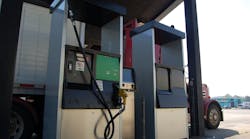Since the beginning of the month, diesel and gasoline prices across the U.S. have been on the rise. And this week is no different.
According to data tracked by the Energy Information Administration (EIA), though diesel and gasoline prices continued to increase this week, they remain far lower compared to the same period in 2014.
The EIA said the average U.S. retail pump price for diesel jumped 2.6 cents this week to $2.904 per gallon, which is $1.030 per gallon cheaper compared to the same week in 2014.
Diesel prices increased in every region of the country, breaking the $3 per gallon mark in six areas:
-
California, up 1.8 cents to $3.268 per gallon;
-
The Central Atlantic, up 7 tenths of a cent to $3.158;
-
The West Coast including California, up 2.3 cents to $3.162;
-
New England, up 2 tenths of a cent to $3.093;
-
The East Coast, up nearly a cent to $3.007;
-
The West Coast without California, up 3.1 to $3.033.
The biggest one-week hike in diesel prices occurred in the Midwest, EIA said, where diesel spiked 4.3 cents per gallon to reach $2.791 per gallon.
Average U.S. retail pump prices for gasoline climbed 5.3 cents this week to $2.744 per gallon, the agency noted, though that is 92.1 cents cheaper compared to the same week last year.
Gasoline prices increased in every region of the U.S., with the West Coast including California and the West Coast without California above the $3-per-gallon mark at $3.513 per gallon, up 6.9 cents from last week, and at $3.005, up 5.7 cents, respectively.
The regions with the largest one-week jumps in gasoline prices are the Midwest – up nearly 9 cents to $2.597 per gallon – and the West Coast, up nearly 7 cents to $3.513 per gallon, EIA reported.
The EIA’s latest “Today in Energy” brief, looks at the decline of petroleum use in the transportation sector and the increase in alternative fuel.
“In the United States, petroleum is by far the most-consumed transportation fuel,” according to EIA. “But recently, the share of fuels other than petroleum for U.S. transportation has increased to its highest level since 1954, a time when the use of coal-fired steam locomotives was declining and automobile use was growing rapidly. The recent increase can be mostly attributed to increased blending of biomass-based fuels with traditional vehicle fuels and growing use of natural gas in the transportation sector.”




